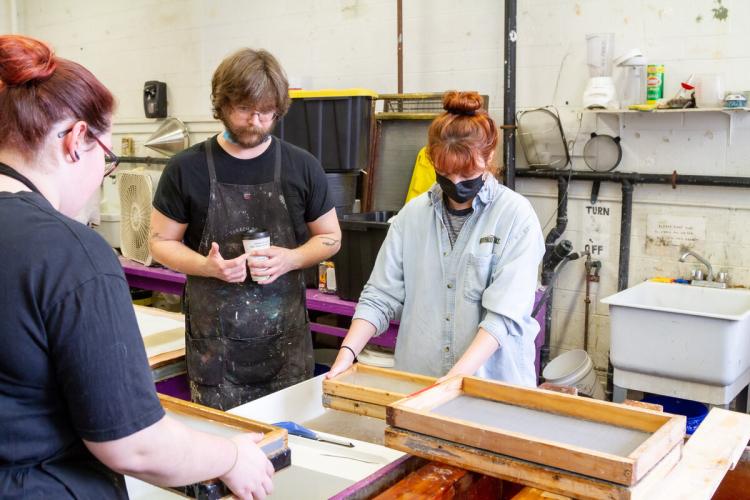
How OHIO alum and hemp papermaker incorporates sustainability into his practice

Athens native and Ohio University alum Matthew Presutti has found a unique way to incorporate sustainability into his printmaking processes by using hemp. He recently provided this insight to Ohio University students as part of the College of Fine Arts’ Visiting Artists and Scholars program.
Currently a studio technician at the Milwaukee Institute of Art and Design, the 2005 printmaking graduate has spent the last few years developing self-taught methods through trial and error to make hemp-based paper. When the Cannabis Museum reached out to professor of printmaking Melissa Haviland for someone to teach a hemp papermaking workshop, she knew her former student Presutti would be a great asset.
“He was just really excited to see what kind of papers could happen, what would make the best papers, and how to tweak that and control that to make better papers for printmaking,” Haviland said.
Although this wasn’t his first time working with OHIO students, having helped processed about 2,000 pieces of paper with OHIO honor students in 2021, Presutti explained it is still a relatively new discipline.
“It’s kind of cool to think about [how] the whole hemp thing wasn’t even a possibility four years ago,” he said. “[The Farm Bill of 2018] allowed hemp to be a legal crop in the U.S.”
Presutti started hemp-based papermaking in 2019 after the papermaking program at the Milwaukee Institute of Art and Design was up and running. In 2017, the Institute received a paper beater and a letterpress printing machine that allowed it to create its own paper.
“A friend of mine reached out to the school because they knew that we were doing this work,” Presutti said. “And they were like, ‘My dad grew these experimental CBD plots … Do you want the biomass that was left over after their harvest?’”
According to Presutti, the timing was just right for this project but after huge boxes of raw materials were dropped off to the studio, it seemed daunting.
“She even sent us a bunch of stuff that still had the hemp flowers on them,” he said. “So, we get it, and I don’t know what to do with all this stuff. Some of the other faculty members were a little weirded out … like, is it illegal? It was really funny.”
Presutti also explained that outside of how new and daunting this process was, what is great about it is having the advantage to make your own paper and complete control over the process. Due to this, printmakers can produce a higher-quality paper that can be used for sculpture, printmaking and more, even if the process takes a little longer.
“The process of papermaking is labor-intensive,” Presutti said.
He spent a full day with students just gathering the raw hemp material. The next step was to soak the material in water and allow bacteria to digest it, making the hemp fibers easier to remove.
“It takes a few days for natural bacteria to get in there and start eating the lignans away that attach the bast fibers, and that can take up to five days,” he said, referring to the strong odor the process emits.
Next, the fibers are cooked down in a lye solution for two to three hours. The cooked solution then becomes a pulp that can be run through machinery and dried into paper. According to Presutti, this one batch can make about 40 to 50 sheets of paper.

Courtney Hans, a first-year student studying interior architecture, attended Presutti’s open studio on April 7 because she was interested in exploring all the art classes offered at OHIO.
“I wasn’t exposed to any of it before I came here, and it’s been really fun to try different things out,” Hans said. “I really like getting my hands dirty and I feel like every single time I walk around another corner here, it’s something new.”
Jaquelee Chau, a first-year MFA student in the printmaking program, said papermaking is relatively new to her, but she enjoys the process.
“I, personally, have not worked with hemp before, and that is a completely different fiber,” Chau said. “Just seeing how those papers are turning out … even with the different treatments of the same fiber, too.”
What makes Presutti’s process and insights using hemp even more valuable is his dedication to the sustainability aspect of it after seeing how coal mining negatively impacted the region’s environmental stability while he was growing up.
“One of the big things that I think about a lot is the sustainability element,” he said. “I’m using [paper] as a vehicle for printing and for my own creative practice. What does it say if I’m able to produce all of my paper … that materials have been sourced within 100 miles of where I live?”
He adds that he must also be mindful of his disposal of the papermaking byproducts, such as the lye solution, that have the potential to be very harmful to the environment.
“The shop that I work at in Milwaukee, we’re right on the Milwaukee River so it’s already super polluted,” Presutti said. “The less stuff I put down the drain, the better.”
He hopes the future of papermaking means producing the same quality paper as major companies but doing so in a way that encourages taking responsibility for the materials.
“At the end of the day, why wouldn’t we try to create systems that are better?” he said.
